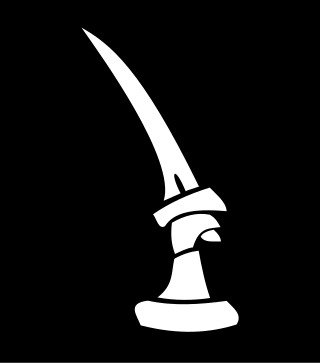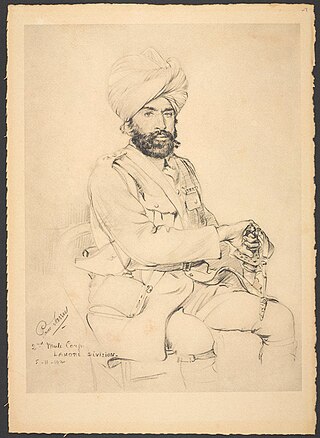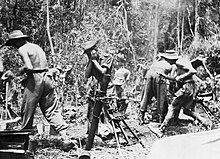
The 5th Indian Infantry Division was an infantry division of the Indian Army during World War II that fought in several theatres of war and was nicknamed the "Ball of Fire". It was one of the few Allied divisions to fight against three different armies - the Italian, German and Japanese armies.
The Order of battle of the Chindits, an Allied special force which carried out two deep penetration raids behind Japanese line during the Burma campaign in the South-East Asian Theatre of World War II

The 17th Infantry Division is a formation of the Indian Army. During the Second World War, it had the distinction of being continually in combat during the three-year-long Burma Campaign. The division was re-raised in 1960 and the 17 Mountain Division is presently located in Sikkim under XXXIII Corps.

The 20th Indian Infantry Division was an infantry division of the Indian Army in the Second World War, formed in India, and took part in the Burma Campaign during the Second World War. After the war, the bulk of the division was deployed to French Indochina to oversee the handover from Japanese to French rule. For nearly all is operational life the division was commanded by Major-General Douglas Gracey. The division's history is subject of open source and historical records research, including the Order of Battle, on an open access, WW2 history website and subject of updates in August 2021

The 7th Infantry Division is a war-formed infantry division, part of the British Indian Army that saw service in the Burma Campaign.

The 10th Indian Infantry Division was a war formed infantry division of the Indian Army during World War II. In four years, the division travelled over 4,000 miles (6,400 km) from Tehran to Trieste, fought three small wars, and fought two great campaigns: the Anglo-Iraqi War, the Invasion of Syria–Lebanon, the Anglo-Soviet invasion of Iran, the North African Campaign, and the Italian Campaign.
The Malaya Command was a formation of the British Army formed in the 1920s for the coordination of the defences of British Malaya, which comprised the Straits Settlements, the Federated Malay States and the Unfederated Malay States. It consisted mainly of small garrison forces in Kuala Lumpur, Penang, Taiping, Seremban and Singapore.

The 23rd Indian Infantry Division was an infantry division of the Indian Army during World War II. It fought in the Burma Campaign. It was then reformed as a division of the independent Indian Army in 1959.

The 26th Indian Infantry Division, was an infantry division of the Indian Army during World War II. It fought in the Burma Campaign.

The 25th Indian Infantry Division was an infantry division of the Indian Army during World War II which fought in the Burma Campaign. It was re-raised within the post-independence Indian Army in 1948.

The 3rd (Lahore) Division was an infantry division of the Indian Army and before 1895, the Bengal Army, first organised in 1852. It saw service during World War I as part of the Indian Corps in France before being moved to the Middle East where it fought against troops of the Ottoman Empire.
The 8th (Lucknow) Division was a formation of the British Indian Army's Northern Army that was first formed as a result of the Kitchener reforms of the Indian Army in 1903. The Division remained in India on internal security duties during World War I, though the 8th (Lucknow) Cavalry Brigade was transferred to the 1st Indian Cavalry Division and served in France on the Western Front, and the 22nd Lucknow Infantry Brigade served as part of the 11th Indian Division in Egypt.
The 14th Indian Division was formed during World War I, for service in the Mesopotamian Campaign. It was composed of battalions of the Regular British Army, the British Territorial Force and the British Indian Army.
The Indian Army had no standby force ready in 1971 with the specific task of attacking East Pakistan, one of the many reasons why India did not immediately intervene after Pakistan launched Operation Searchlight in March 1971. Indian Army's Eastern Command was tasked with defending the northern and eastern borders and fighting the insurgencies in Nagaland, Mizoram and Naxalites in West Bengal at that time.
The Burma Division was a static formation of the British Indian Army. It was created as part of the 1903 reforms of the Indian Army by Herbert Kitchener, 1st Earl Kitchener then Commander-in-Chief, India. The task of such formations was to oversee area brigades commanding Internal Security troops. The formation is best thought of as a provincial or district command rather than as an infantry division. The headquarters of the division was at Maymyo.
The Burma Corps ('Burcorps') was an Army Corps of the Indian Army during the Second World War. It was formed in Prome, Burma, on 19 March 1942, took part in the retreat through Burma, and was disbanded on arrival in India in May 1942.

The 5th Indian Infantry Brigade was an infantry brigade formation of the Indian Army during World War II. It was converted from the 9th Indian Infantry Brigade in September 1939, and assigned to the 4th Indian Infantry Division. The brigade first moved to Egypt and took part in the early battles in North Africa. Then in 1941, it moved to the Sudan with the 5th Indian Infantry Division. Returning to 4th Indian Division command it took part in the Syria-Lebanon Campaign. The brigade then returned to North Africa coming under command of the 5th and 10th Indian Infantry Divisions, and the 50th (Northumbrian) Infantry Division and the 51st (Highland) Infantry Division in the Campaign in Tunisia. The brigade once more returned to the 4th Division for the Italian Campaign and the Greek Civil War.
Second Battle of Monte Cassino order of battle February 1944 is a listing of the significant formations that were involved in the fighting on the Winter Line in February 1944 during the period generally known as the Second Battle of Monte Cassino.
In September 1939, the British Army was in process of expanding their anti-aircraft and mobile assets. Among these new changes was the formation of Anti-Aircraft Command which was formed on 1 April 1939, and the 1st Armoured Division formed in 1937. The list below will include the British Army units, colonial units, and those units which were in the process of formation.
The Structure of the Egyptian Expeditionary Force over the course of the First World War is shown below.














